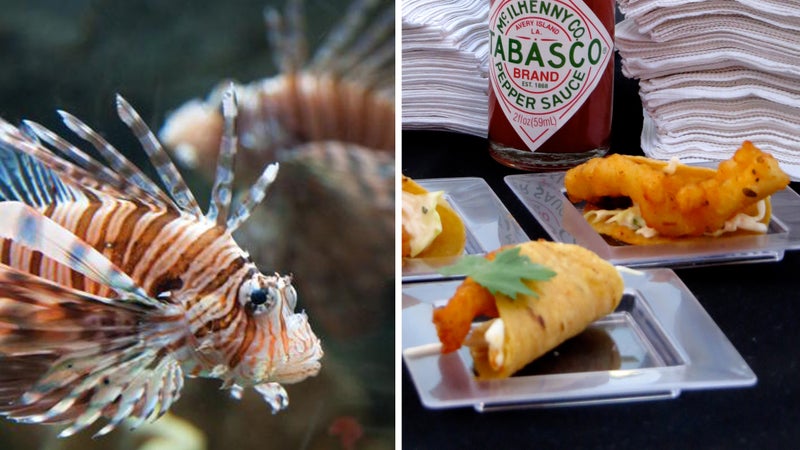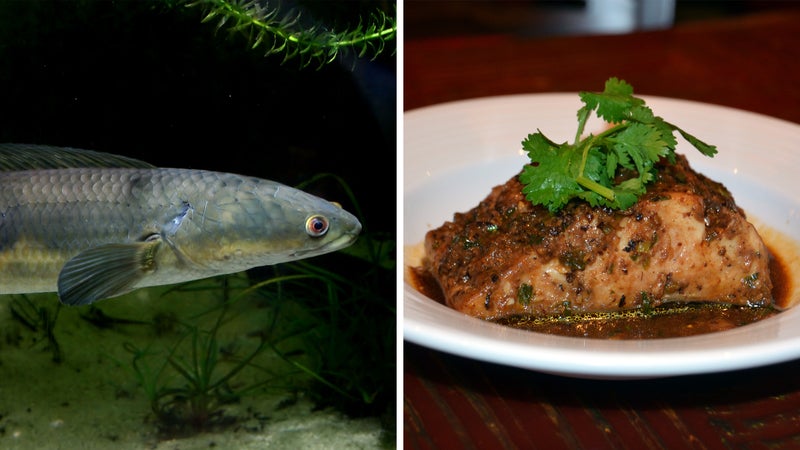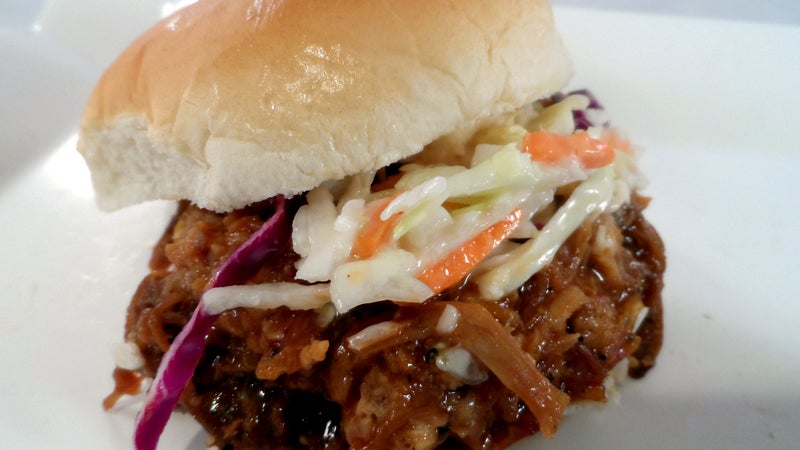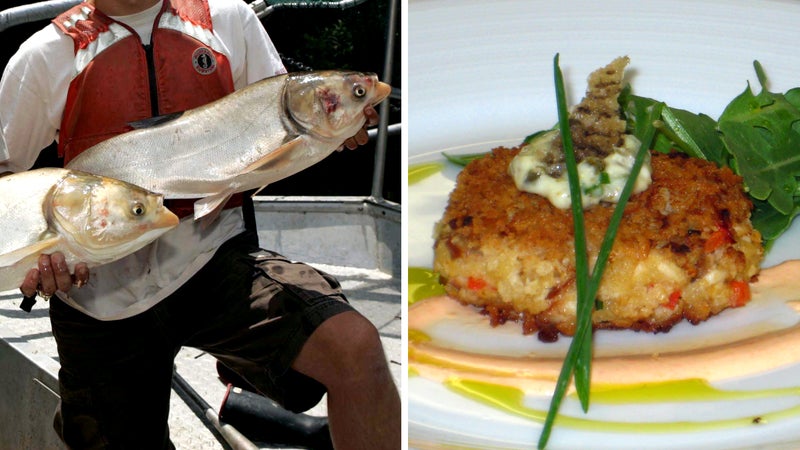America’s real immigration crisis involves invasive critters and plants.
In 2011, the Department of Interior spent $100 million on controlling and stopping the spread of invasives (also known as exotics). From pythons wriggling through the Everglades to brown trout crowding out humpback chub in the Grand Canyon, many exotics are here to stay. Since we can’t eradicate them, management is our best way forward.
As the old saying goes, if you can’t beat them, eat them. Many of these species are edible, some are even delicious, leading environmentally minded chefs to put invasives on menus in hopes of introducing them to a wider audience. But you don’t have to be a professional to cook and enjoy them. Here are five invasives you could easily be eating, and how to cook them.

Nutria
These rodents were originally brought to the Gulf Coast for their fur, but “a combination of human and weather events resulted in them being released,” says Scott Leysath, host of Dead Meat, a TV show about killing, cooking, and eating invasives—from armadillos to iguana to pythons.
The problem with nutria is that they breed quickly—up to 13 babies can be born at once, and a mother can mate again just two days after giving birth. They also eat like crazy—growing up to 20 pounds, these rodents make short work of wetlands.
“These guys have an image problem,” Leysath says. “They look like a drowned rat. But they taste absolutely fine; there’s nothing wrong with them, you’ve had worse.” (“You’ve had worse” probably isn’t the best slogan to launch nutria’s rebranding campaign.)
For his show on nutria, Leysath and the crew shot the creatures with .22-caliber rifles. Then he went low and slow with the meat. “Anything you can do with a lean cut of pork you could do with this meat,” he says.
Nutria Chile Verde
Ingredients
3 pounds nutria meat (about 6 cups), cut into 1-inch pieces
3 tablespoons vegetable oil
1 1/2 quarts chicken broth
2 cups yellow onion, chopped
8 garlic cloves, chopped
2 green bell peppers, chopped
1 red bell pepper, chopped
2 Anaheim peppers, chopped
3 jalapeno peppers, seeded and diced
1 tablespoon dried oregano flakes
2 tablespoons chili powder
2 tablespoons ground cumin
1 teaspoon cayenne pepper
2 cups fresh tomatillos, skin removed; quartered (or canned/drained)
1 cup fresh cilantro leaves, chopped
Salt and pepper to taste
Preparation
- Heat oil in a large stockpot over medium-high heat. Add nutria and brown evenly.
- Add 1 quart chicken broth and any additional broth or water to cover meat and bring to a boil. Reduce heat and simmer, covered, for 2 hours or until meat is tender and breaks apart, but doesn’t fall apart with moderate finger pressure. Drain liquid from stockpot.
- Add remaining 2 cups of chicken stock and all other ingredients except cilantro. Simmer until peppers are tender. Stir in cilantro and season with salt and pepper to taste.
- Serve with warm flour tortillas, shredded lettuce, tomato, cheese, sour cream and cold Mexican beer (optional, kind of).

Lionfish
Native to the Western Pacific, it’s believed that lionfish entered the Atlantic in 1992 during Hurricane Andrew, when a beachside aquarium on Biscayne Bay just outside of Miami broke. In the Atlantic, the fish have no natural predators and they eat like marathoners pillaging a stash of day-old bagels. One study found that over a span of five weeks, a single lionfish could reduce the numbers of juvenile fish on a reef by 80 percent.
Luckily, lionfish are pretty tasty. Unluckily, they have venomous spikes that carry a mild toxin. Most divers report their prick to be somewhere between a bee sting and a stingray barb to the arm. “The first thing someone should do is cut off the barbs,” says Tenney Flynn, the executive chef and owner of GW Fins in New Orleans. “I haven’t been stuck yet but it’s like having sharp knives around—I think the stick is coming sometime in the future.”
Chef Flynn says lionfish have a tender texture and a mild flavor. Since they have to be harvested by spear fishermen, (lionfish don’t bite on lines and as of this moment there isn’t a great way to trap them), buying the fish wholesale can be surprisingly expensive. But if you’re willing to go diving, most states encourage you to kill every one you see.
GW Fins’ Tempura-fried Lionfish Tacos
Ingredients for the slaw
1 cup Blue Plate mayonnaise
1 chipotle pepper in adobo
1 tablespoon Adobo sauce
2 tablespoon Fresh lime juice
1 teaspoon Creole seasoning
1 pinch salt
1 pinch pepper
2 cups shredded cabbage
½ cup finely sliced red pepper
½ cup Chopped green onions
¼ cup Finely chopped cilantro
Blend the mayonnaise, chipotle, adobo sauce, lime juice, creole seasoning, salt and pepper together in a small bowl. Place veggies in a large bowl and then pour on chipotle dressing and toss thoroughly.
Ingredients for the fish
1/2 pound lionfish (or you can use trout if you can’t find lionfish) cut into 3-inch pieces
2 teaspoon Creole seasoning
Oil for frying
Ingredients for the batter
1 cup cornstarch
1 cup all-purpose flour
1 pinch baking soda
1 pinch baking powder
1 teaspoon Creole seasoning
1 bottle light beer
Preparation
- Mix the dry ingredients in a mixing bowl and mix in beer. Add a handful of ice and stir. Let sit until ice is melted.
- Sprinkle fish with creole seasoning and then dip into batter. Heat your oil to 360 degrees. Drop the pieces of fish into the hot oil and deep fry, moving back and forth, for 2-3 minutes. Place on paper towels to blot extra oil.
- Meanwhile, brown white corn tortillas in a hot skillet.
To assemble, place slaw on corn tortillas, then add one or two pieces of fish. Garnished with avocados, tomatoes, chopped green onions and diced cilantro.

Snakehead
These frankenfish were first discovered in Maryland in 2002. It’s believed they were brought over for use in Asian fish markets and then somehow escaped. Snakeheads are able to live for several days out of water, and like the lionfish, they have no natural predators in North America. When they were first discovered, biologists feared the fish would wreck local ecosystems, but that prediction hasn’t completely come true. Still, if you catch a snakehead, law prohibits you from throwing it back.
Not that you’d want to. “The snakehead is a really delicious fish with a really good yield,” says Peter Gebauer, executive chef for the Potawatomi Hotel & Casino in Milwaukee, where he oversees seven restaurants. “I buy them whenever I can get some. The name itself is a little scary; it sounds like something you’d see on ‘River Monsters,’” he says, adding that guests are often a little nervous about it. “We don’t hide what it is though. It’s an opportunity for us to make a difference in the environment and educate the public.”
Gebauer prefers to stay authentic to the snakehead’s roots, serving it in a traditional Asian black bean sauce.
Steamed Snakehead with Black Beans & Ginger
Ingredients
6 ounces snakehead, fillet with skin on
½ teaspoon garlic, minced
½ stalk green onion, fine diced
2 slices ginger, peeled and thin julienne
3 springs cilantro, fine chopped
½ teaspoon sugar, granulated
½ teaspoon sesame oil
½ teaspoon rice cooking wine
½ teaspoon chili oil (optional)
1 teaspoon black mushroom soy sauce
1 tablespoon soy sauce
1 tablespoon preserved black beans & ginger
1 pinch white pepper, ground
Preparation
- Place fish in pan, skin side up.
- In a small bowl, mix all remaining ingredients together.
- Place mixed ingredients on top of fish.
- Steam for 8 minutes or until done.
- Place in center of a warm plate for service and top with the liquid.
- Garnish with cilantro.
- Serve with steamed rice.

Wild Hog
Mississippi State University produced a video series on our nation’s hog problem called “A Pickup Load of Pigs.” In one episode, a Texas state official says, “With over 2 million hogs in Texas, we’re not going to barbeque our way out of this problem.” Maybe not, but it sure would be fun to try.
Wild hogs, whose populations have boomed due to domesticated pigs getting loose, destroy native vegetation and tear up the ground, often causing erosion. “It’s a real problem all over the sunbelt. In warmer climates they reproduce like crazy,” says Leysath.
They’re good eating, though. “You can prepare them any way you’d prepare traditional pork; it’s just leaner.” Just be wary of trichinosis. Leysath says that for this reason he cooks his wild boar meat to at least 160 degrees. “Trichinosis dies at 137 degrees but I don’t like to mess around with it.”
Pulled Wild Hog Sandwiches

Ingredients
1 wild hog shoulder or hindquarter roast, bone in or out
1/4 cup Kosher salt
1/4 cup brown sugar
1/4 cup paprika
2 tablespoons each black pepper, onion powder, garlic powder
1 tablespoon cayenne pepper
2 cups barbecue sauce
Plastic wrap
Heavy-duty aluminum foil
Ingredients for the dipping sauce
1/2 cup red wine vinegar
1/4 cup low-sodium soy sauce
2 tablespoons brown sugar
1 teaspoon hot sauce
Burger buns
Coleslaw
Preparation
- Combine rub ingredients and evenly coat roast. Wrap with plastic wrap and refrigerate for at least six hours and up to 48 hours.
- Smoke, roast or grill (covered) at 250 degrees for six to eight hours or until the internal temperature away from the bone is 180 degrees. If desired, first brown the roast evenly in a hot oven or on a hot grill. This will give the roast additional flavor and extra crunch on the edges.
- Place the roast on top of two or three long sheets of heavy-duty foil. Pour barbecue sauce over roast and wrap snugly with foil so that sauce will not run out. Place back in the 250 degree oven, smoker or grill for another two hours.
- Combine dipping sauce ingredients in a tight-fitting jar and shake vigorously to mix. Remove roast and allow to cool enough to handle. Shred meat with fingers, tongs, or forks.
- Place a mound of pulled meat on the bottom half of each bun. Top with slaw and serve with dipping sauce on the side.

Asian Carp
Since being introduced via fish farms in the 1970s, Asian carp (which is the catch-all for four different species of non-native carp) have slowly expanded their range. Each year they inch closer and closer to the Great Lakes. According to the National Wildlife Federation, some varieties of Asian carp can eat up to 20 percent of the bodyweight in plankton each day. Add in the fact that females lay half a million eggs at a time, and it’s easy to see how the fish have spread so fast.
Unlike snakehead and lionfish, Asian carp are a tougher sell. The meat isn’t bad, it’s just that “it’s a lot of labor for not a lot of fish,” says Gebauer. Still, he’s had them on the menu at his restaurants since 2012, mostly as a public service, he says. Gebauer describes the meat as “like a mix between crab and sea scallop.” He often serves it in a ceviche or fries it into fishcakes.
Chef Gebauer’s Smoked Asian Fish Cakes
Ingredients
½ cup mayonnaise
1 teaspoon Dijon mustard
1 egg
1 teaspoon extra virgin olive oil
½ cup onion, small diced
½ cup red pepper, small diced
¼ bunch parsley, minced
½ teaspoon Old bay seasoning
1 pound smoked boneless silver fin (alternatively crab meat or smoked trout can be used.)
¾ cup panko bread crumbs
To taste salt and pepper, chives, arugula
Preparation
- Combine mayonnaise, mustard and eggs, and chill.
- Sauté onion and red pepper in extra virgin olive oil until softened. Allow to cool.
- Combine onion, red pepper, mayonnaise, mustard, egg, parsley, salt, pepper, and old bay seasoning.
- Gently fold the mayonnaise mixture into fish and panko. Be very careful to not shred the flesh of the meat.
- Add salt and pepper to taste.
- Shape into two once cakes and chill for 30 minutes in the refrigerator.
- Pan fry and serve with tartar sauce or aioli
- Garnish with chive and arugula

